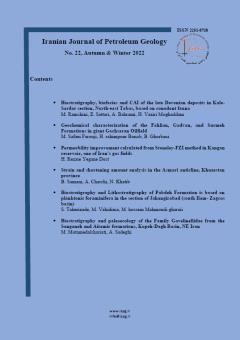Permeability improvement calculated from Stoneley-FZI method in Kangan reservoir, one of Iran's gas fields
Subject Areas : Petrophysics
hossein rezaie yegane doost
1
*
![]()
1 - Shahrood university
Keywords: Permeability, Kangan, multi-resolution graph-based clustering (MRGC), ST-FZI method,
Abstract :
Permeability in fluid flow is for a porous rock, which is exactly what causes the problem. core analysis and well testing are two most commonly used methods of permeability measurement, but in-vitro measurement of permeability by applying core analysis on all wells in a specific field is very time consuming and costly and even impossible when dealing with Horizontal wells. Wells testing, on the other hand, is not cost-effective for reasons such as; High costs and zero production during the testing process. Therefore, thanks to their low cost, comprehensiveness and availability, permeability estimation methods developed according to conventional logs land DSI diagrams are of critical importance. Taking this into account, in the present study, permeability was first estimated using multi-resolution graph-based clustering (MRGC) and the results were compared with permeability rates obtained from core analysis. In the second stage, permeability was measured by ST-FZI method and the results were compared with permeability rates obtained from core analysis. In the third stage, the multi-resolution graph-based clustering (MRGC) method was used to improve the permeability calculated by the ST-FZI method and overcome the reservoir heterogeneity. First the flow units were identified, and then the ST-FZI method was applied on each flow unit to calculate permeability and finally the calculated permeabilities were combined to obtain an accurate permeability graph of the studied well. The correlation coefficients of permeability rates estimated via core analysis in the multi-resolution graph-based clustering method (R2 = 77), ST-FZI method (R2 = 47) and improved method (R2 = 84) were measured. The afore-mentioned method was able to improve the permeability calculated in the previous step by 37% and was recognized as the best permeability measurement method in the Kangan reservoir of the well subjected to study.
o Al-Adani N and Barati A (2003) New hydraulic unit permeability approach with DSI. In: SPWLA 9th formation evaluation symposium, Japan pp. 25–26.
o Brie A, Endo T, Johnson DL and Pampuri F (1998) Quantitative formation permeability evaluation from Stoneley waves. In: SPE annual technical conference and exhibition. Society of Petroleum Engineers
o Elkatatny S, Mahmoud M, Tariq Z, Abdulraheem A (2018) New insights into the prediction of heterogeneous carbonate reservoir permeability from well logs using artificial intelligence network. Neural Comput Appl 30(9):2673–2683
o Mohaghegh S, Balan B, Ameri S (1997) Permeability determination from well log data. SPE Form Eval 12(03):170–174
o Perez HH, Datta-Gupta A, Mishra S (2005) The role of electrofacies, lithofacies, and hydraulic flow units in permeability predictions from well logs: a comparative analysis using classification trees. SPE Reserv Eval Eng 8(02):143–155
o Rafik B, Kamel B (2017) Prediction of permeability and porosity from well log data using the nonparametric regression with multivariate analysis and neural network, Hassi R’Mel Field, Algeria. Egypt J Pet 26(3):763–778
o Rezaei MH, Chehrazi A (2010) Principles of implantation and interpretation of well surveyors. Tehran University Press, Tehran
o Soleimani B, Moradi M, Ghabeishavi A (2018) Stoneley wave predicted permeability and electrofacies correlation in the Bangestan Reservoir, Mansouri Oilfield. SW Iran Geofísica Internacional 57(2):107–120
o Wu X and Yin H (2010) ExxonMobil Upstream Research Co. Method for determining reservoir permeability form borehole Stoneley-wave attenuation using Biot's poroelastic theory. U.S. Patent 7,830,744
o Ye SJ and Rabiller P (2000) A new tool for electro-facies analysis: multi-resolution graph-based clustering. In: SPWLA 41st annual logging symposium. Society of Petrophysicists and Well-Log Analysts
o Anifowose, F.A., Abdulraheem, A., Al-Shuhail, A.A. and Schmitt, D.P., 2013, March. Improved permeability prediction from seismic and log data using artificial intelligence techniques. In SPE Middle East Oil and Gas Show and Conference. Society of Petroleum Engineers.
o Jamalian, M., Safari, H. and Goodarzi, M., 2018, June. Permeability Prediction Using Artificial Neural Network and Least Square Support Vector Machine Methods. In 80th EAGE Conference and Exhibition 2018.
o Vardian, M., Nasriani, H.R., Faghihi, R., Vardian, A. and Jowkar, S., 2016. Porosity and permeability prediction from well logs using an adaptive neuro-fuzzy inference system in a naturally fractured gas-condensate reservoir. Energy Sources, Part A: Recovery, Utilization, and Environmental Effects, 38(3), pp.435-441.

